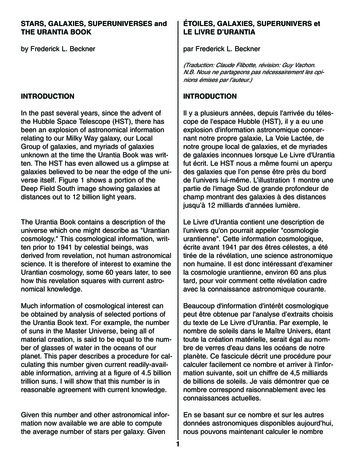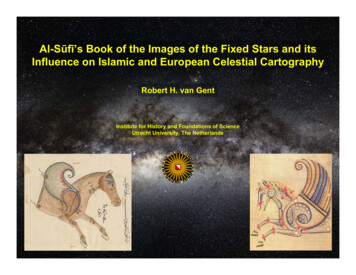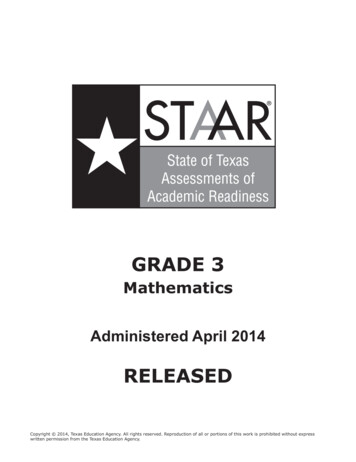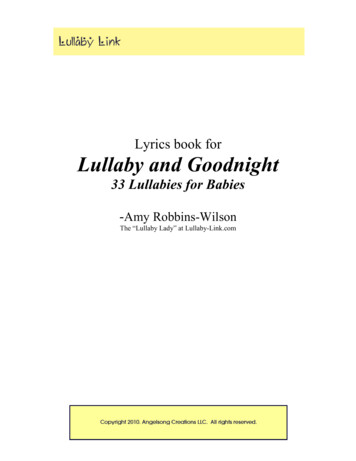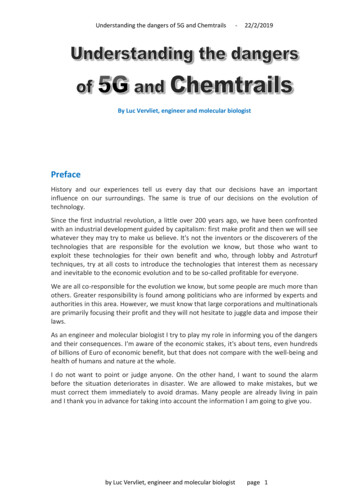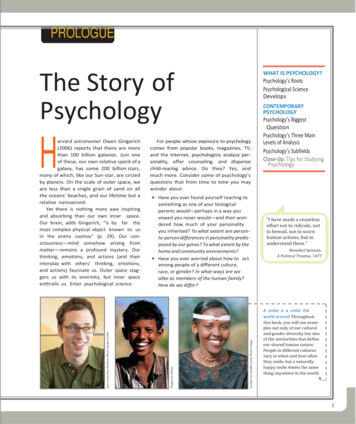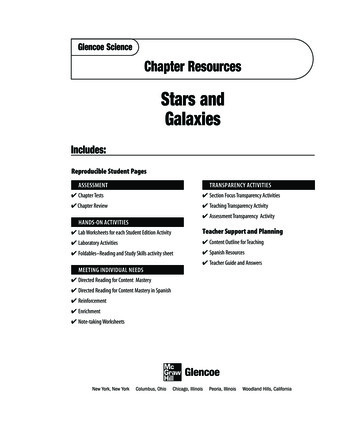
Transcription
Glencoe ScienceChapter ResourcesStars andGalaxiesIncludes:Reproducible Student PagesASSESSMENTTRANSPARENCY ACTIVITIES Chapter Tests Section Focus Transparency Activities Chapter Review Teaching Transparency ActivityHANDS-ON ACTIVITIES Assessment Transparency Activity Lab Worksheets for each Student Edition ActivityTeacher Support and Planning Laboratory Activities Content Outline for Teaching Foldables–Reading and Study Skills activity sheet Spanish Resources Teacher Guide and AnswersMEETING INDIVIDUAL NEEDS Directed Reading for Content Mastery Directed Reading for Content Mastery in Spanish Reinforcement Enrichment Note-taking Worksheets
Glencoe SciencePhoto CreditsSection Focus Transparency 1: Zefa/Kulka/The Stock MarketSection Focus Transparency 2: European Space Agency/Science Photo Library/PhotoSection Focus Transparency 3: Mark Garlick/Science Photo Library/Photo ResearchersSection Focus Transparency 4: Roger Ressmeyer/CORBISCopyright by The McGraw-Hill Companies, Inc. All rights reserved.Permission is granted to reproduce the material contained herein on the conditionthat such material be reproduced only for classroom use; be provided to students,teachers, and families without charge; and be used solely in conjunction with theStars and Galaxies program. Any other reproduction, for use or sale, is prohibitedwithout prior written permission of the publisher.Send all inquiries to:Glencoe/McGraw-Hill8787 Orion PlaceColumbus, OH 43240-4027ISBN 0-07-866962-6Printed in the United States of America.1 2 3 4 5 6 7 8 9 10 071 09 08 07 06 05 04
ReproducibleStudent PagesReproducible Student Pages Hands-On ActivitiesMiniLAB: Try at Home Observing Star Patterns . . . . . . . . . . . . . . . . . 3MiniLAB: Measuring Distance in Space . . . . . . . . . . . . . . . . . . . . . . . . 4Lab: Sunspots . . . . . . . . . . . . . . . . . . . . . . . . . . . . . . . . . . . . . . . . . . . . 5Lab: Design Your Own Measuring Parallax . . . . . . . . . . . . . . . . . . . . . 7Laboratory Activity 1: Absolute and Apparent Magnitudes . . . . . . . . . 9Laboratory Activity 2: Spectral Analysis . . . . . . . . . . . . . . . . . . . . . . . 13Foldables: Reading and Study Skills. . . . . . . . . . . . . . . . . . . . . . . . . . 17 Meeting Individual NeedsExtension and InterventionDirected Reading for Content Mastery . . . . . . . . . . . . . . . . . . . . . . . 19Directed Reading for Content Mastery in Spanish . . . . . . . . . . . . . . 23Reinforcement . . . . . . . . . . . . . . . . . . . . . . . . . . . . . . . . . . . . . . . . . . 27Enrichment. . . . . . . . . . . . . . . . . . . . . . . . . . . . . . . . . . . . . . . . . . . . . 31Note-taking Worksheet . . . . . . . . . . . . . . . . . . . . . . . . . . . . . . . . . . . 35 AssessmentChapter Review . . . . . . . . . . . . . . . . . . . . . . . . . . . . . . . . . . . . . . . . . 41Chapter Test . . . . . . . . . . . . . . . . . . . . . . . . . . . . . . . . . . . . . . . . . . . . 43 Transparency ActivitiesSection Focus Transparency Activities . . . . . . . . . . . . . . . . . . . . . . . . 48Teaching Transparency Activity . . . . . . . . . . . . . . . . . . . . . . . . . . . . . 53Assessment Transparency Activity . . . . . . . . . . . . . . . . . . . . . . . . . . . 55Stars and Galaxies1
Hands-On ActivitiesHands-OnActivities2 Stars and Galaxies
DateClassHands-On ActivitiesNameObserving Star PatternsProcedure1. On a clear night, go outside after dark and study the stars. Take an adultwith you.2. Let your imagination flow to find patterns of stars that look like somethingfamiliar.3. Draw the stars you see, note their positions, and include a drawing of whatyou think each star pattern resembles.Copyright Glencoe/McGraw-Hill, a division of the McGraw-Hill Companies, Inc.Data and ObservationsAnalysis1. Which of your constellations match those observed by your classmates?2. How can recognizing star patterns be useful?Stars and Galaxies3
NameDateClassProcedure1. On a large sheet of paper, draw an overhead view of the Milky Way.If necessary, refer to Figure 16 in your textbook. Choose a scale to showdistance in light-years.2. Mark the approximate location of the solar system, which is abouttwo thirds of the way out on one of the spiral arms.3. Now, draw a side view of the Milky Way Galaxy. Mark the position of thesolar system.Analysis1. What scale did you use to represent distance on your model of the Milky Way?2. The Andromeda Galaxy is about 2.9 million light-years from Earth. What scale distance wouldthis represent?Copyright Glencoe/McGraw-Hill, a division of the McGraw-Hill Companies, Inc.Hands-On ActivitiesMeasuring Distance in Space4 Stars and Galaxies
NameDateClassHands-On ActivitiesSunspotsLab PreviewDirections: Answer these questions before you begin the Lab.1. What safety cautions are needed for this lab?2. Why do sunspots appear to move?Sunspots can be observed moving across the face of the Sun as it rotates.Measure the movement of sunspots, and use your data to determine the Sun’speriod of rotation.Figure 1Real-World QuestionCan sunspot motion be used to determine theSun’s period of rotation?Copyright Glencoe/McGraw-Hill, a division of the McGraw-Hill Companies, Inc.Materialsseveral bookspiece of cardboarddrawing paperrefracting telescopeclipboardsmall dGoals Observe sunspots and estimate their size.Estimate the rate at which sunspots moveacross the face of the Sun.DrawingpaperSafety PrecautionsWARNING: Handle scissors with care.TripodBooksProcedure1. Find a location where the Sun can be viewedat the same time of the day for a minimumof five days. WARNING: Do not look directlyat the Sun. Do not look through the telescopeat the Sun. You could damage your eyes.2. If the telescope has a small finder scopeattached, remove it or keep it covered.3. Set up the telescope with the eyepiece facing away from the Sun, as shown. Align thetelescope so that the shadow it casts on theground is the smallest size possible. Cut andattach the cardboard as shown in Figure 1.4. Use books to prop the clipboard upright.Point the eyepiece at the drawing paper.5. Move the clipboard back and forth untilyou have the largest image of the Sun onthe paper. Adjust the telescope to form aclear image. Trace the outline of the Sun onthe paper.6. Trace any sunspots that appear as darkareas on the Sun’s image. Repeat this stepat the same time each day for a week.Stars and Galaxies5
NameDateClass(continued)9. Predict how many days it will take for thesame group of sunspots to return to thesame position in which they appeared onday 1.Data and ObservationsSunspot DescriptionsDay 1Day 2Day 3Day 4Day 5Number ofSunspotsSizeEstimateConclude and Apply1. What was the estimated size and rate of motion of the largest sunspots?2. Infer how sunspots can be used to determine that the Sun’s surface is not solid like Earth’ssurface.Communicating Your DataCompare your conclusions with those of other students in your class. For more help,refer to the Science Skill Handbook.6 Stars and GalaxiesCopyright Glencoe/McGraw-Hill, a division of the McGraw-Hill Companies, Inc.Hands-On Activities7. Using the Sun’s diameter (approximately1,390,000 km), estimate the size of thelargest sunspots that you observed.8. Calculate how many kilometers thesunspots move each day.
NameDateClassDesign Your OwnHands-On ActivitiesMeasuring ParallaxLab PreviewDirections: Answer these questions before you begin the Lab.1. Why is the safety symbol for eye protection used in this lab?2. What is parallax?Parallax is the apparent shift in the position of an object when viewed fromtwo locations.Real-World QuestionHow can you build a model to show therelationship between distance and parallax?Form a HypothesisState a hypothesis about how parallax varieswith distance.Copyright Glencoe/McGraw-Hill, a division of the McGraw-Hill Companies, Inc.Possible Materialsmeterstickmetric rulermasking tapepencilGoals Design a model to show how the distancefrom an observer to an object affects theobject’s parallax shift.Describe how parallax can be used to determine the distance to a star.Safety PrecautionsWARNING: Be sure to wear goggles to protectyour eyes.Test Your HypothesisMake a Plan1. As a group, agree upon and write yourhypothesis statement.2. List the steps you need to take to buildyour model. Be specific, describing exactlywhat you will do at each step.3. Devise a method to test how distance froman observer to an object, such as a pencil,affects the parallax of the object.4. List the steps you will take to test yourhypothesis. Be specific, describing exactlywhat you will do at each step.5. Read over your plan for the model to beused in this experiment.6. How will you determine changes inobserved parallax? Remember, these changesshould occur when the distance from theobserver to the object is changed.7. You should measure shifts in parallax fromseveral different positions. How will thesepositions differ?8. How will you measure distances accuratelyand compare relative position shift?Follow Your Plan1. Make sure your teacher approves your planbefore you start.2. Construct the model your team hasplanned.3. Carry out the experiment as planned.4. While conducting the experiment, recordany observations that you or other membersof your group make in the Data and Observations section.Stars and Galaxies7
NameDateClass(continued)Analyze Your Data1. Compare what happened to the object when it was viewed with one eye closed, then the other.2. At what distance from the observer did the object appear to shift the most?3. At what distance did it appear to shift the least?Conclude and Apply1. Infer what happened to the apparent shift of the object’s location as the distance from theobserver was increased or decreased.2. Describe how astronomers might use parallax to study stars.Communicating Your DataPrepare a chart showing the results of your experiment. Share the chart with members ofyour class. For more help, refer to the Science Skill Handbook.8 Stars and GalaxiesCopyright Glencoe/McGraw-Hill, a division of the McGraw-Hill Companies, Inc.Hands-On ActivitiesData and Observations
Date1LaboratoryActivityClassAbsolute and ApparentMagnitudesThe apparent magnitude of a star, or how much light is received on Earth, can be confusing toan astronomer trying to measure the distance a star is from Earth. Apparent magnitude is muchdifferent from the absolute magnitude, which is the true measure of how much light the star emits.These two variables control the brightness of the stars we see in our night sky. The absolute magnitude is not the same for every star. It is determined by the amount of light it gives off. The secondvariable is the amount of light received on Earth. The mixing of these two variables can lead tomisunderstanding about the size and distance of a star. That is why it is important to understand thecharacteristics of stars and light to be able to correctly determine what we see in the night sky.StrategyYou will observe how light behaves over distance.You will predict how two stars that are different in size and far away from each other may appearin the night sky.Materialsblack construction paperscissorssmall flashlightrubber bandsmedium sized nailtapeCopyright Glencoe/McGraw-Hill, a division of the McGraw-Hill Companies, Inc.Procedure1. Students will work in groups of three tofour. Use your scissors to cut a piece ofblack construction paper large enough tocomfortably cover the light end of theflashlight.2. Cover the end of the flashlight with thepaper and secure it in place with a rubberband. Take the sharp end of the nail andcarefully poke a single hole in the centerof the paper covering. The smaller thehole the better.3. Find a wall or hard surface on which youcan tape a background of more black construction paper. An area about one metersquare would be best for the experiment.An alternate choice would be to use theblack- or white-board in the classroom. Ifyou do use a wall, write only with theappropriate materials, such as chalk orerasable marker.4. At a distance of two meters or six feet fromthe wall, mark a spot with tape on theground. Then mark the next interval at 1.3meters or four feet. The last mark is at 0.6meters or two feet.measuring tape or meterstickwhite correction fluid*chalk* markers* Alternate materialsFigure 15. Ask your instructor to darken the room asmuch as possible. One student will stand atthe six foot mark and turn on the flashlight. The other students will mark theedges of the diameter of the circle of lightmade by the flashlight with correctionfluid, chalk, or markers. Be sure to noticethe intensity of the inner and outer regionsof the circle of light. You will record this inthe data table provided.Stars and Galaxies9Hands-On ActivitiesName
NameDateClassLaboratory Activity 1 (continued)7. Observe the behavior of light at differentintervals. Try to account for what youobserve by what you know. For instance,you know the amount of light exiting theflashlight has not changed at all duringthe experiment. So what is happening tothe dispersal of light? Record yourhypothesis in the space marked “Hypothesis for the dispersal of light.”Data and ObservationsTable 1Diameter of Light Circle (cm)Trial 1Trial 2Observations about Intensity of Light (cm)Trial 3Copyright Glencoe/McGraw-Hill, a division of the McGraw-Hill Companies, Inc.Hands-On Activities6. Repeat this procedure at the closer interval.Then repeat one more time at the closestinterval. Look at the intensity of the lightinstead. When is it most intense and whereis it very diffuse? Record these observationsin your table.10 Stars and Galaxies
NameDateClassAccording to your experiment, your circle of light changed in size as you got closer to the wall.The intensity, or brightness, also changed. How would you account for this? Write your hypothesisin the space below.Hypothesis for the dispersal of light:Questions and Conclusions1. The circle of light produced by your flashlight on the wall was larger when you were fartheraway from the wall. Was the light more or less intense? How do you account for this?Copyright Glencoe/McGraw-Hill, a division of the McGraw-Hill Companies, Inc.2. The circle of light got smaller as you approached the wall. Was the light more or less intense?How do you account for this?3. As a result of your experiment, would you expect a star to appear brighter when closer to orfarther from the Earth? Explain your answer.4. If you used a bigger and brighter flashlight and repeated the same experiment, what would youexpect your results to be like? Explain your answer.Stars and Galaxies11Hands-On ActivitiesLaboratory Activity 1 (continued)
NameDateClassLaboratory Activity 1 (continued)6. How would you model the difference in absolute magnitude between the two flashlights?7. Predict what an astronomer would look for if he or she wanted to determine the size and heatof a star and its distance from the Earth. Would it be a good idea to watch the star over a longperiod?Strategy CheckCan you observe how light behaves over distance?Can you predict how two stars that are different in size and far away from each other mayappear in the night sky?12 Stars and GalaxiesCopyright Glencoe/McGraw-Hill, a division of the McGraw-Hill Companies, Inc.Hands-On Activities5. Suppose you were going to perform the experiment with two students: One holds a weak flashlight; the other a strong flashlight. How would you place the students so that the circles of lighton the wall were exactly the same size? Explain your answer in terms of magnitude.
Date2LaboratoryActivityClassSpectral AnalysisThe photograph of the spectrum of a star, sorted by color across a plate, will reveal spectral linesupon close examination. The lines are produced by elements in a star at high temperature. Theselines represent the chemical composition of the star. Each element has its own “fingerprint.” Toanalyze the spectra of stars, scientists collected spectra of all the known elements. If we compare thespectral lines of an unknown star with the spectral lines of elements, we can determine the chemicalcomposition of the star. More recently, we have discovered not only the composition of the stars butalso their temperatures, their rotational rate, and their relative motion with regard to Earth.StrategyYou will construct a simple spectral analyzer.You will determine the composition of a star using the spectral analyzer.You will determine other characteristics of a star by comparing the spectral lines with a standard.MaterialsscissorsCopyright Glencoe/McGraw-Hill, a division of the McGraw-Hill Companies, Inc.Procedure1. Turn to the third page of this lab. Cut outthe pull tab card; the spectroscope fingerprints card; and Stars B, C, and D along thedashed lines.2. Make five slits along the dashed lines A, B,C, D, and E on the fingerprints card.3. From left to right, insert “Pull Tab Out” upthrough slit E, down through slit D, upthrough slit C, down through slit B, and upthrough slit A.4. Compare the lines of each known elementwith the lines of Star A. If lines match, thenthat element is present in Star A. Recordyour findings in Table 1.5. Star B, Star C, and Star D are provided forfurther study and comparison. Each can beplaced over Star A.Data and ObservationsTable 1StarChemical CompositionOther CharacteristicsABCDStars and Galaxies13Hands-On ActivitiesName
NameDateClassLaboratory Activity 2 (continued)1. When you hear someone say that neon lights look beautiful, what color comes to mind? Whatcolor is suggested by the “fingerprints” of neon?2. Did any of the stars have the same chemical composition? Look at the table.3. Sometimes scientists see spectral lines that do not fit the usual pattern. The lines might beshifted from their usual positions. This may suggest that the star is moving either toward theobserver (shift toward the blue) or away from the observer (shift toward the red). Look at thespectral lines for Star B and Star D. Star B is the standard for comparison. How is Star Ddifferent? What is a possible explanation for the difference?4. If the scientist sees the spectral lines wider than usual, he or she relates this spectral broadeningto either rotational speed (the broader the faster), temperature (the broader the hotter), orpressure (the broader the greater pressure). Look at the spectral lines for Star B and Star C. StarB is the standard. How is Star C different? What could be a possible explanation?Strategy CheckCan you construct a simple spectral analyzer?Can you determine the composition of a star using the spectral analyzer?Can you determine other characteristics of a star by comparing the spectral lineswith a standard?14 Stars and GalaxiesCopyright Glencoe/McGraw-Hill, a division of the McGraw-Hill Companies, Inc.Hands-On ActivitiesQuestions and Conclusions
NameDateClassHands-On ActivitiesLaboratory Activity 2 nBlueIndigoPull Tab OutNeonSpectrogram of unknown starEDCASodiumdoubletLeft hand filmStar ARight hand filmStar BStar CIronCalciumStar DSodiumHydrogenHeliumArgonMercuryIdentify theelementsin the starA70006000 A5000 AA0040Copyright Glencoe/McGraw-Hill, a division of the McGraw-Hill Companies, Inc.BStars and Galaxies15
NameDateClassHands-On ActivitiesStars and GalaxiesDirections: Use this page to label your Foldable at the beginning of the chapter.StarsGalaxiesUniverseIt can become a giant, a supergiant, or white dwarf.It is a large group of stars, gas, and dust held together by gravity.Copyright Glencoe/McGraw-Hill, a division of the McGraw-Hill Companies, Inc.It is accepted that this started with the Big Bang.Magnitude is a measure of its brightness.We live in the Milky Way.Stars and Galaxies17
Meeting Individual NeedsMeeting IndividualNeeds18 Stars and Galaxies
NameDateDirected Reading forContent MasteryClassOverviewStars and GalaxiesDirections: Unscramble each term to complete the concept map below.salaxige1.Meeting Individual Needsare composed oftrass2.Copyright Glencoe/McGraw-Hill, a division of the McGraw-Hill Companies, Inc.that can bethiwe frawdsnima quescnee3.4.antigsstaruepings5.6.Directions: Use the terms from the concept map to complete the sentences below.7. Most stars are stars.8. In the late stages of their life cycle, stars can expand to becomeor .9. A is a star that has contracted after using itssupply of helium.10. are large groups of stars, gas, and dust heldtogether by gravity.Stars and Galaxies19
NameDateDirected Reading forContent MasterySection 1Section 2 ClassStarsThe SunDirections: Circle the term that correctly completes each sentence.1. Patterns of stars in the sky are called (galaxies/constellations).2. Constellations that circle Polaris are (circumpolar/binary).3. Scientists use (telescopes/spectographs) to break visible light from a star into itscomponent colors.5. The absolute (magnitude/brightness) of a star is a measure of the amount oflight it gives off.6. A measure of the amount of light received on Earth is called the (absolute/apparent)magnitude.Directions: Identify the following parts of the Sun in the spaces provided.prominencesurfacesunspot8.9.7.20 Stars and GalaxiesCopyright Glencoe/McGraw-Hill, a division of the McGraw-Hill Companies, Inc.Meeting Individual Needs4. Distances in space are measured in (light-years/CMEs).
NameDateDirected Reading forContent MasteryClassSection 3 Section 4 Evolutionof StarsGalaxies andthe UniverseDirections: Identify the stages in the life cycle of an average star. Use the words below to fill in the blanks.white dwarfnebulagiantmain sequence1. Star begins in a clouds of gas and dust.that balances the pull of gravity.3. Star’s core is exhausted of hydrogen; its outer layers expand and cool.4. Star’s core is exhausted of helium; its outer layers escape into space leaving onlythe core; the core contracts, or gets smaller.Copyright Glencoe/McGraw-Hill, a division of the McGraw-Hill Companies, Inc.Directions: Identify the type of galaxy shown in each illustration. Use the words to fill in the blanks below.irregularspiralelliptical5. 6. 7.Directions: Answer the questions below on the lines provided.8. In which galaxy is our solar system?9. What is the name for the change in a star’s spectrum when it moves awayfrom Earth?10. What is the theory that explains how the universe began with an enormousexplosion?Stars and Galaxies21Meeting Individual Needs2. Star continues to use hydrogen for energy; heat from fusion causes pressure
NameDateDirected Reading forContent MasteryClassKey TermsStars and GalaxiesDirections: Write the letter of the term that correctly completes each sentence in the space at the left.1. is a measure of the amount of light a star actually gives off.a. Apparent magnitudeb. Absolute magnitude2. A is a large group of stars, gas, and dust held together by gravity.a. solar systemb. galaxya. chromosphereb. corona4. Distances between stars and galaxies are measured in .a. light-yearsb. millions of kilometers5. An object so dense that nothing can escape its gravity field is a .a. white dwarfb. black hole6. A is a group of stars that form a pattern in the sky.a. constellationb. flare7. A star beginning as a large cloud of gas and dust is called a .a. nebulab. neptune8. The Milky Way is a(n) galaxy.a. spiralb. elliptical9. Areas of the Sun’s surface that appear dark because they are coolerthan surrounding areas are called .a. CMEsb. sunspots10. The collapsed core of a supernova that contains only neutrons isa .a. neutron star22 Stars and Galaxiesb. super giantCopyright Glencoe/McGraw-Hill, a division of the McGraw-Hill Companies, Inc.Meeting Individual Needs3. The largest layer of the Sun’s atmosphere is the .
NombreFechaLectura dirigida paraDominio del contenidoClaseSinopsisLas estrellas y las galaxiasInstrucciones: Decifra cada término para completar el siguiente mapa de conceptos.salaxigaSatisface las necesidades individuales1.están compuestas detasrelesl2.Copyright Glencoe/McGraw-Hill, a division of the McGraw-Hill Companies, Inc.que pueden serasnaen anasblcieres ianrlcpip3.4.gaesngituersp igtaneg5.6.Instrucciones: Utiliza los términos del mapa de conceptos para completar las siguientes oraciones.7. La mayoría de las estrellas son estrellas .8. En las etapas tardías de sus ciclos de vida, las estrellas pueden expandirse yconvertirse en ó.9. Un(a) es una estrella que se ha contraídodespués de agotar su provisión de helio.10. Las son grandes grupos de estrellas, gas y polvoque se mantienen juntos gracias a la gravedad.Las estrellas y las galaxias23
NombreFechaLectura dirigida paraDominio del contenidoSección 1Sección 2Clase Las estrellasEl SolInstrucciones: Encienrra en un círculo el término que complete correctamente cada oración.1. Los patrones de estrellas en el firmamento se llaman (galaxias/constelaciones).2. Las constelaciones alrededor de Polaris se llaman (circunpolares/binarias).4. Las distancias en el espacio se miden en (años luz/CMEs).5. El(La) (magnitud/brillo) absolut(o)a de una estrella es una medida de la cantidadde luz que despide.6. Una medida de la cantidad de luz que recibe la Tierra se llama magnitud(absoluta/aparente).Instrucciones: Identifica las siguientes partes del Sol en el diagrama.prominenciasuperficiemancha solar8.9.7.24 Las estrellas y las galaxiasCopyright Glencoe/McGraw-Hill, a division of the McGraw-Hill Companies, Inc.Satisface las necesidades individuales3. Los científicos usan (telescopios/espectrógrafos) para separar la luz provenientede una estrella en los colores que la componen.
NombreFechaLectura dirigida paraClaseSección 3 Sección 4 Dominio del contenidoEvolución delas estrellasLas galaxias yel universo1. Una estrella comienza como una nube de gas y polvo.2. La estrella comienza a usar hidrógeno como combustible; el calor de la fusióncausa presión que equilibra la fuerza de gravedad.3. El núcleo de la estrella agota el oxígeno; sus capas exteriores se expanden y seenfrían.4. El núcleo de la estrella agota el helio; sus capas exteriores escapan al espacio dejando sólo el núcleo; el núcleo se hace más pequeño.Instrucciones: Identifica el tipo de galaxia de cada ilustración. Usa los términos para llenar los espacios en blanco.Copyright Glencoe/McGraw-Hill, a division of the McGraw-Hill Companies, Inc.irregularen espiralelíptica5. 6. 7.Instrucciones: Contesta las preguntas en el espacio dado.8. ¿En cuál galaxia está nuestro sistema solar? .9. ¿Qué nombre recibe el cambio en el espectro de una estrella, a medida que se aleja dela Tierra? .10. ¿Cuál es la teoría que explica el comienzo del universo como una enorme explosión?Las estrellas y las galaxias25Satisface las necesidades individualesInstrucciones: Identifica las etapas del ciclo de vida de una estrella promedio. Usa los siguientes términos parallenar los espacios en blanco.enanas blancasnebulosagiganteserie principal
NombreFechaLectura dirigida paraDominio del contenidoClaseTérminos clavesEstrellas y galaxiasInstrucciones: Escribe en el espacio a la izquierda la letra del término que complete correctamente cadaoración.1. La es una medida de la cantidad de luz que emite una estrella.a. Magnitud aparenteb. Magnitud absolutaa. sistema solarb. galaxia3. La capa más grande de la atmósfera del Sol es la .a. cromosferab. corona4. Las distancias entre las estrellas y las galaxias se miden en .a. años luzb. millones de kilómetros5. Un astro cuya gravedad es tan fuerte que nada escapa de su campo degravedad es un(a) .a. enana blancab. agujero negro6. Una es un grupo de estrellas que forman un patrón en el cielo.a. constelaciónb. llamarada7. Una estrella que comienza como una gran nube de gas y polvo se llama.a. nebulosab. neptuno8. La Vía Láctea es una galaxia .a. espiralb. elíptica9. Las áreas que se ven oscuras en la superficie del Sol porque son más fríasque las áreas circundantes se llaman .a. CMEsb. manchas solares10. El núcleo colapsado de una supernova que contiene solamente neutrones es una .a. estrella de neutrones26 Las estrellas y las galaxiasb. super giganteCopyright Glencoe/McGraw-Hill, a division of the McGraw-Hill Companies, Inc.Satisface las necesidades individuales2. Un(a) es un grupo grande de estrellas, gas y polvo que semantienen unidos gracias a la gravedad.
NameDate1ClassStarsReinforcementDirections: Use the clues provided to solve the crossword puzzle.132457Meeting Individual Needs69810111213Copyright Glencoe/McGraw-Hill, a division of the McGraw-Hill Companies, Inc.14Across3. The Big Dipper is part of this constellation. (2 words)4. Relatively cool stars look either orange orthis color.5. This is the amount of starlight received onEarth. (2 words)6. This is the brightest star in the sky.7. Our Sun is a star of this color.10. This the actual amount of light that a stargives off. (2 words)13. This is another name for the North Star.14. These are groups of stars thatform patterns.Down1. The North Star is in this constellation.(2 words)8. This is the distance of about 9.5 trillionkilometers that light travels in one year.(2 words)9. Astronomers study these to learn aboutthe properties of stars.11. This constellation, named after a mythicalhunter, includes the star Betelgeuse.12. Even though this star has an absolutemagnitude greater than that of Sirius, itlooks dimmer fr
Glencoe Science Chapter Resources Stars and Galaxies Includes: Reproducible Student Pages ASSESSMENT Chapter Tests Chapter Review HANDS-ON ACTIVITIES Lab Worksheets for each Student Editi
